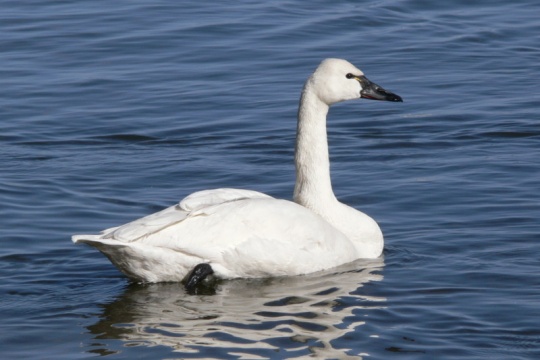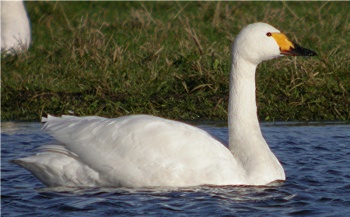
Photo © by Paul Tavares
Hamilton Harbour, Ontario, Canada, 17 March 2006
- Cygnus columbianus
Includes Whistling Swan, Bewick's Swan
Identification
Length 120–150 cm (47¼-59 in); wingspan 170-210 cm; weight 3.4-9.6 kg (see further under the Subspecies section)
- Large, though smaller than other swans
- Adult with all white plumage, juvenile pale grey-brown
- Black bill, with yellow base of variable size in front of eye (the yellow area is pinkish in juveniles)
Similar species
Trumpeter Swan is larger and lacks yellow on bill. Whooper Swan is also larger, but has more extensive yellow on the bill, the yellow coming to an acute point. Holds neck straight up, unlike Mute Swan, which bends its neck in a graceful curve.
Distribution
Whistling Swan breeds in arctic Canada and Alaska, and migrates to the Lower 48 US States, with concentrations in Washington, Oregon and California in the west, and New Jersey to South Carolina in the east; smaller numbers winter in many other states. Bewick's Swan breeds from European Russia east to the Taymyr Peninsula, and migrates across the White Sea and Baltic to winter in northwestern Europe from Denmark and north Germany to Belgium and in parts of England and (rarely) Ireland. Small numbers winter in north-west France and in the Camargue. Main passage periods are March-April and October-November. Wintering sites are usually traditionally used areas but in severe weather there may be considerable wandering. In the Western Palearctic breeds only on the coasts of Arctic Russia, on Ostrov Kolguyev and Novaya Zemlya.
Vagrancy
Recorded as a vagrant north to Svalbard and Bear Island, to most mainland European countries and south to Cyprus, North Africa and Jordan. Whistling Swan has also occurred a few times in western Europe and eastern Asia, and Bewick's Swan a few times in North America, in each case mixing with the other subspecies.
Taxonomy
Subspecies
There are two subspecies[1]:
- C. c. columbianus - Whistling Swan:
- Tundra of arctic North America; winters to western and coastal eastern USA
- Larger; length 120-150 cm, wingspan 180-210 cm, weight 4.3-9.6 kg. Bill mostly black, with a tiny yellow spot.
- C. c. bewickii - Bewick's Swan:
- Kola Peninsula to arctic northern Siberia; winters western Europe, southwest Asia, and eastern Asia.
- Smaller; length 115-140 cm, wingspan 170-195 cm, weight 3.4-7.8 kg. Bill black with large yellow area at base, with curved (not acute) apex.
Some authorities have treated the two as separate species; see this thread for discussion.
A few older authorities have also treated eastern Asian populations of Bewick's Swan as a third subspecies Cygnus columbianus jankowskii, or (if accepting the Bewick's split) as Cygnus bewickii jankowskii, but it is now rarely considered distinct from Bewick's, with no significant morphological or genetic evidence to support its separation.
Habitat
Breeds on pools and lakes in areas of open swampy tundra, sometimes along slow-flowing rivers or on sheltered sea-coasts. On passage on lakes and rivers, sometimes on coasts, and in winter in wetland areas with open water and often flooded fields. These long-established wintering grounds may not be occupied for the entire winter but may be used as a base from which the birds look for new feeding areas.
Behaviour
Breeding
The 4-6 creamy-white eggs are placed on a large mound of grass and moss on an island or beside a marshy tundra lake.
Vocalisation
References
- Clements, J. F., T. S. Schulenberg, M. J. Iliff, D. Roberson, T. A. Fredericks, B. L. Sullivan, and C. L. Wood. 2018. The eBird/Clements checklist of birds of the world: v2018. Downloaded from http://www.birds.cornell.edu/clementschecklist/download/
- Carboneras, C. & Kirwan, G.M. (2019). Tundra Swan (Cygnus columbianus). In: del Hoyo, J., Elliott, A., Sargatal, J., Christie, D.A. & de Juana, E. (eds.). Handbook of the Birds of the World Alive. Lynx Edicions, Barcelona. (retrieved from https://www.hbw.com/node/52808 on 1 April 2019).
- Limpert, R. J. and S. L. Earnst (1994). Tundra Swan (Cygnus columbianus), version 2.0. In The Birds of North America (A. F. Poole and F. B. Gill, Editors). Cornell Lab of Ornithology, Ithaca, NY, USA. https://doi.org/10.2173/bna.89
Recommended Citation
- BirdForum Opus contributors. (2025) Tundra Swan. In: BirdForum, the forum for wild birds and birding. Retrieved 11 May 2025 from https://www.birdforum.net/opus/Tundra_Swan
External Links
GSearch checked for 2020 platform.1





